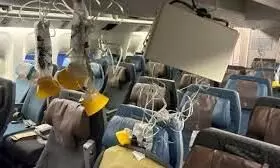
Singapore Airlines aircraft was in a dangerous zone during turbulence: report
text_fieldsLondon: The Singapore Airlines flight could have ended up in a difficult region in the equator leading to turbulence killing one passenger and injuring several others, said a former pilot.
The Boeing 777 made an emergency landing in Thailand following the deadly turbulence a couple of days ago.
British passenger Geoffrey Kitchen, 73, died of a heart attack on flight SQ321, and nearly 60 passengers were injured in the May 21 incident.
Marco Chan, a former commercial pilot and lecturer in aviation at Buckinghamshire New University, said the flight could have been in an area called the Intertropical Convergence Zone (ICZ).
ICZ is a region that circles the Earth near the equator where the trade winds of the Northern and Southern hemisphere come together, according to NASA Earth Observatory.
The humidity content in the region is high from intense heat of the Sun and warm water of the equator.
Because of the convergence of the trade winds buoyant air rises and expands and then cools. The process releases accumulated moistures in a continuous series of thunderstorms.
According to Marco Chan in such a scenario, pilots' options may have been limited.
"With turbulence of such magnitude, it is likely the Singapore Airlines flight was navigating through difficult thunderstorms," The Wall Street Journal (WSJ) quoted Chan as saying.
Though thunderstorms are displayed on the pilots’ navigation display, circumventing the storm cluster, stretching over 50 nautical miles, may not be completely possible, he told The Guardian.
Meanwhile, Singapore Airlines on Wednesday said it is cooperating with the investigation.























